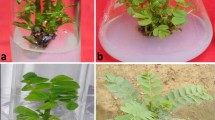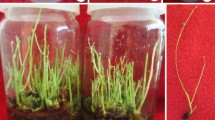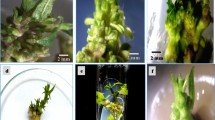Abstract
An efficient and improved in vitro propagation method has been developed for Arnebia hispidissima, a medicinally and pharmaceutically important plant species of arid and semiarid regions. Nodal segments (3–4 cm) with two to three nodes obtained from field grown plants were used as explants for shoot proliferation. Murashige and Skoog’s (MS) medium supplemented with cytokinins with or without indole-3-acetic acid (IAA) or naphthalene acetic acid was used for shoot multiplication. Out of different PGRs combinations, MS medium containing 0.5 mg l−1 6-benzylaminopurine and 0.1 mg l−1 IAA was optimal for shoot multiplication. On this medium, explants produced the highest number of shoots (47.50 ± 0.38). About 90 % of shoots rooted ex vitro on sterile soilrite under the greenhouse condition when the base (2–4 mm) of shoots was treated with 300 mg l−1 of indole-3-butyric acid for 5 min. The plantlets were hardened successfully in the greenhouse with 85–90 % survival rate. Random amplified polymorphic DNA (RAPD) and inter-simple sequence repeat (ISSR) markers were employed to assess the genetic stability of in vitro-regenerated plants of A. hispidissima. Out of 40 (25 RAPD and 15 ISSR) primers screened, 15 RAPD and 7 ISSR primers produced a total number of 111 (77 RAPD and 34 ISSR) reproducible amplicons. The amplified products were monomorphic across all the micropropagated plants and were similar to the mother plant. To the best of our knowledge, it is the first report on the assessment of the genetic fidelity in micropropagated plants of A. hispidissima.



Similar content being viewed by others
References
Verpoorte, R., Vander Heijden, R., & Memelink, J. (2000). Engineering the plant cell factory for secondary metabolite production. Transgenic Research, 9, 323–343.
Vaishnav, P., & Demain, A. L. (2010). Unexpected applications of secondary metabolites. Biotechnology Advances, 29, 223–229.
Singh, S. K., Rai, M. K., Asthana, P., & Sahoo, L. (2009). An improved micropropagation of Spilanthes acmella through thin cell layer culture. Acta Physiologiae Plantarum, 31, 693–698.
Shekhawat, M. S., & Shekhawat, N. S. (2011). Micropropagation of Arnebia hispidissima (Lehm). DC. and production of alkannin from callus and cell suspension culture. Acta Physiologiae Plantarum, 33, 1445–1450.
Vibha, J. B., Choudhary, K., Singh, M., Rathore, M. S., & Shekhawat, N. S. (2009). An efficient somatic embryogenesis system for velvet bean [Mucuna pruriens (L.) DC.]: a source of anti Parkinson’s drug. Plant Cell Tissue and Organ Culture, 99, 319–325.
Rathore, M. S., Chikara, J., & Shekhawat, N. S. (2011). Plantlet regeneration from callus cultures of selected genotype of Aloe vera L.—an ancient plant for modern herbal industries. Applied Biochemistry and Biotechnology, 163, 860–868.
Papageorgiou, V. P., Assimopoulou, A. N., Couladouros, E. A., Hepworth, D., & Nicolaou, K. C. (1999). The chemistry and biology of alkannin, shikonin, and related naphthazarin natural products. Angewandte Chemie International Edition, 38, 270–300.
Narula, A., Kumar, S., Bansal, K. C., & Srivastava, P. S. (2004). Biotechnological approaches towards improvement of medicinal plants. In P. S. Srivastava, A. Narula, & S. Srivastava (Eds.), Plant biotechnology and molecular markers (pp. 78–116). New Delhi: Anamaya.
Singh, S. K., Rai, M. K., & Sahoo, L. (2012). An improved and efficient micropropagation of Eclipta alba through transverse thin cell layer culture and assessment of clonal fidelity using RAPD analysis. Industrial Crops and Products, 37, 328–333.
Rathore, M. S., Chikara, J., Mastan, S. G., Rahman, H., Anand, K. V. G., & Shekhawat, N. S. (2011). Assessment of genetic stability and instability of tissue culture-propagated plantlets of Aloe vera L. by RAPD and ISSR markers. Applied Biochemistry and Biotechnology, 165, 1356–1365.
Nayak, S. A., Kumar, S., Satapathy, K., Moharana, A., Behera, B., Barik, D. P., et al. (2013). In vitro plant regeneration from cotyledonary nodes of Withania somnifera (L.) Dunal and assessment of clonal fidelity using RAPD and ISSR markers. Acta Physiologiae Plantarum, 35, 195–203.
Asthana, P., Jaiswal, V. S., & Jaiswal, U. (2011). Micropropagation of Sapindus trifoliatus L. and assessment of genetic fidelity of micropropagated plants using RAPD analysis. Acta Physiologiae Plantarum, 33, 1821–1829.
Bhatia, R., Singh, K. P., Sharma, T. R., & Jhang, T. (2011). Evaluation of the genetic fidelity of in vitro-propagated gerbera (Gerbera jamesonii Bolus) using DNA-based markers. Plant Cell Tissue and Organ Culture, 104, 131–135.
Kumar, S., Mangal, M., Dhawan, A. K., & Singh, N. (2011). Assessment of genetic fidelity of micropropagated plants of Simmondsia chinensis (Link) Schneider using RAPD and ISSR markers. Acta Physiologiae Plantarum, 33, 2541–2545.
Rai, M. K., Phulwaria, M., Harish Gupta, A. K., Shekhawat, N. S., & Jaiswal, U. (2012). Genetic homogeneity of guava plants derived from somatic embryogenesis using SSR and ISSR markers. Plant Cell Tissue and Organ Culture, 111, 259–264.
Faisal, M., Alatar, A. A., Ahmad, N., Anis, M., & Hegazy, A. K. (2012). An efficient and reproducible method for in vitro clonal multiplication of Rauvolfia tetraphylla L. and evaluation of genetic stability using DNA-based markers. Applied Biochemistry and Biotechnology, 168, 1739–1752.
Singh, S. R., Dalal, S., Singh, R., Dhawan, A. K., & Kalia, R. K. (2013). Evaluation of genetic fidelity of in vitro raised plants of Dendrocalamus asper (Schult. & Schult. F.) Backer ex K. Heyne using DNA-based markers. Acta Physiologiae Plantarum, 35, 419–430.
Hamdard, M. E., Badar, Y., & Khan, M. S. Y. (1988). Revised phytochemical study of Arnebia hispidissima. Pakistan Journal of Pharmaceutical Sciences, 1, 19–20.
Khan, H. A., Chandrashekharan, I., & Ghanim, A. (1983). Naphthazarines from Arnebia hispidissima. Phytochemistry, 22, 614–615.
Singh, B., Sahu, P. M., Jain, S. C., & Singh, S. (2004). Estimation of naphthaquinones from Arnebia hispidissima (Lehm.) DC. in vivo and in vitro. I. Anti-inflammatory screening. Phytotherapy Research, 18, 154–159.
Pal, M., & Chaudhury, A. (2010). High frequency direct plant regeneration, micropropagation and shikonin induction in Arnebia hispidissima. Journal of Crop Science and Biotechnology, 13, 13–19.
Phulwaria, M., & Shekhawat, N. S. (2013). An efficient in vitro shoot regeneration from immature inflorescence and ex vitro rooting of Arnebia hispidissima (Lehm). DC.—a red dye (alkannin) yielding plant. Physiology and Molecular Biology of Plants. doi:10.1007/s12298-013-0171-9.
Murashige, T., & Skoog, F. (1962). A revised medium for rapid growth and bioassays with tobacco tissue cultures. Physiologia Plantarum, 15, 473–497.
Doyle, J. J., & Doyle, J. L. (1990). Isolation of plant DNA from fresh tissue. Focus, 12, 13–15.
Phulwaria, M., Ram, K., Gahlot, P., & Shekhawat, N. S. (2011). Micropropagation of Salvadora persica—a tree of arid horticulture and forestry. New Forests, 42, 317–327.
Shekhawat, N. S., Mohnot, S., Phulwaria, M., Harish, & Shekhawat, S. (2012). Micropropagation of Salvadora oleoides—an oil yielding tree of arid forests. Journal of Sustainable Forestry, 31, 620–632.
Phulwaria, M., Rai, M. K., Harish Gupta, A. K., Ram, K., & Shekhawat, N. S. (2012). An improved micropropagation of Terminalia bellirica from nodal explants of mature tree. Acta Physiologiae Plantarum, 34, 299–305.
Phulwaria, M., Ram, K., Harish Gupta, A. K., & Shekhawat, N. S. (2012). Micropropagation of mature Terminalia catappa (Indian almond)—a medicinally important forest tree. Journal of Forest Research, 17, 202–207.
Ram, K., & Shekhawat, N. S. (2011). Micropropagation of commercially cultivated Henna (Lawsonia inermis) using nodal explants. Physiology and Molecular Biology of Plants, 17, 281–289.
Shekhawat, M. S., Shekhawat, N. S., Harish Ram, K., Phulwaria, M., & Gupta, A. K. (2011). High frequency plantlet regeneration from nodal segment culture of female Momordica dioica (Roxb.). Journal of Crop Science and Biotechnology, 14, 133–137.
Phulwaria, M., Shekhawat, N. S., Rathore, J. S., & Singh, R. P. (2013). An efficient in vitro regeneration and ex vitro rooting of Ceropegia bulbosa Roxb.—a threatened and pharmaceutical important plant of Indian Thar Desert. Industrial Crops and Products, 42, 25–29.
Cheruvathur, M. K., & Thomas, T. D. (2011). An efficient plant regeneration system through callus for Pseudarthria viscida (L.) Wright and Arn., a rare ethnomedicinal herb. Physiology and Molecular Biology of Plants, 17, 395–401.
Singh, M., Rathore, M. S., Panwar, D., Rathore, J. S., Dagla, H. R., & Shekhawat, N. S. (2009). Micropropagation of selected genotype of Aloe vera L.—an ancient plant for modern industry. Journal of Sustainable Forestry, 28, 935–950.
Benmahioul, B., Dorion, N., Kaid-Harche, M., & Daguin, F. (2012). Micropropagation and ex vitro rooting of pistachio (Pistacia vera L.). Plant Cell Tissue and Organ Culture, 108, 353–358.
Pospisilova, J., Ticha, I., Kadlecek, P., Haisel, D., & Plzakova, S. (1999). Acclimatization of micropropagated plants to ex vitro conditions. Biologia Plantarum, 42, 481–497.
Yan, H., Liang, C., Yang, L., & Li, Y. (2010). In vitro and ex vitro rooting of Siratia grosvenorii, a traditional medicinal plant. Acta Physiologiae Plantarum, 32, 115–120.
Rathore, M. S., Shekhawat, S., Kaur, G., Singh, R. P., & Shekhawat, N. S. (2012). Micropropagation of vegetable rennet (Withania coagulans [Stocks] Dunal)—a critically endangered medicinal plant. Journal of Sustainable Forestry, 31, 727–746.
Mehrotra, S., Khwaja, O., Kukreja, A. K., & Rahman, L. (2012). ISSR and RAPD based evaluation of genetic stability of encapsulated micro shoots of Glycyrrhiza glabra following 6 months of storage. Molecular Biotechnology, 52, 262–268.
Carra, A., Sajeva, M., Abbate, L., Siragusa, M., Sottile, F., & Carimi, F. (2012). In vitro plant regeneration of caper (Capparis spinosa L.) from floral explants and genetic stability of regenerants. Plant Cell Tissue and Organ Culture, 109, 373–381.
Phulwaria, M., Rai, M. K., Patel, A. K., Kataria, V., & Shekhawat, N. S. (2013). A genetically stable rooting protocol for propagating a threatened medicinal plant—Celastrus paniculatus. AoB Plants. doi:10.1093/aobpla/pls054.
Acknowledgments
The authors (MP, MKR) wish to acknowledge the support of the University Grants Commission, New Delhi, for the award of Post Doctoral Fellowship and Dr. DS Kothari Post Doctoral Fellowship, respectively. We thank Department of Biotechnology, Government of India, New Delhi, for providing funds for the establishment of laboratory and greenhouse infrastructure used for the present research.
Author information
Authors and Affiliations
Corresponding author
Rights and permissions
About this article
Cite this article
Phulwaria, M., Rai, M.K. & Shekhawat, N.S. An Improved Micropropagation of Arnebia hispidissima (Lehm.) DC. and Assessment of Genetic Fidelity of Micropropagated Plants Using DNA-Based Molecular Markers. Appl Biochem Biotechnol 170, 1163–1173 (2013). https://doi.org/10.1007/s12010-013-0266-3
Received:
Accepted:
Published:
Issue Date:
DOI: https://doi.org/10.1007/s12010-013-0266-3




